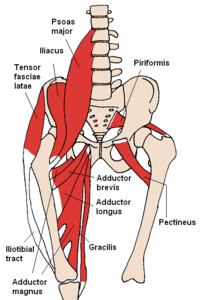
Photo from wikipedia
The position, in a pelvis-embedded anatomical coordinate system, of skin points located over the following anatomical landmarks (AL) was determined while the hip assumed different spatial postures: right and left… Click to show full abstract
The position, in a pelvis-embedded anatomical coordinate system, of skin points located over the following anatomical landmarks (AL) was determined while the hip assumed different spatial postures: right and left anterior superior and posterior superior iliac spines, and the sacrum. Postures were selected as occurring during walking and during a flexion-extension and circumduction movement, as used to determine the hip joint centre position (star-arc movement). Five volunteers, characterised by a wide range of body mass indices (22-37), were investigated. Subject-specific MRI pelvis digital bone models were obtained. For each posture, the pose of the pelvis-embedded anatomical coordinate system was determined by registering this bone model with points digitised over bony prominences of the pelvis, using a wand carrying a marker-cluster and stereophotogrammetry. The knowledge of how the position of the skin points varies as a function of the hip posture provided information regarding the soft tissue artefact (STA) that would affect skin markers located over those points during stereophotogrammetric movement analysis. The STA was described in terms of amplitude (relative to the position of the AL during an orthostatic posture), diameter (distance between the positions of the AL which were farthest away from each other), and pelvis orientation. The STA amplitude, exhibited, over all postures, a median [inter-quartile] value of 9[6] and 16[11]mm, for normal and overweight volunteers, respectively. STA diameters were larger for the star-arc than for the walking postures, and the direction was predominantly upwards. Consequent errors in pelvic orientation were in the range 1-9 and 4-11 degrees, for the two groups respectively.
Journal Title: Journal of biomechanics
Year Published: 2017
Link to full text (if available)
Share on Social Media: Sign Up to like & get
recommendations!